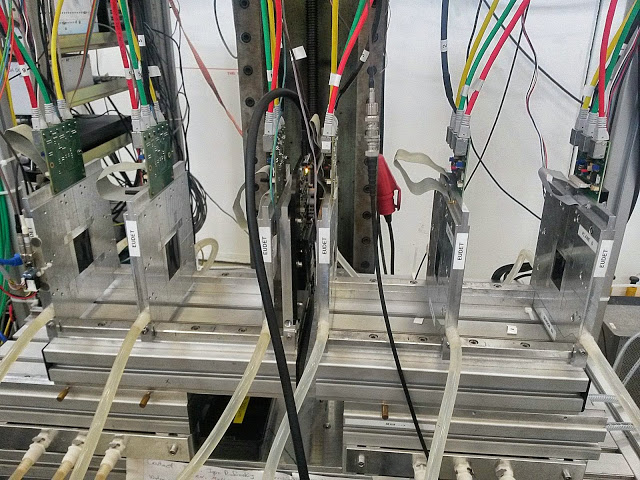Pixel-detector tests for CLIC with the AIDA beam telescope
The PH Linear Collider Detector group (PH-LCD) was the first user of the new AIDA beam telescope in August, taking data with silicon pixel-detector prototypes under development for a future vertex detector at the CLIC high-energy linear electron-positron collider.
The PS-T9 beamline in August 2014. The beam enters from the right, passing through the AIDA pixel telescope and the four parasitic user installations further downstream.
This year's beam tests at CERN are a continuation of the successful data taking campaigns at the DESY electron beam in 2013/14. In both locations the LCD group collaborates closely with the DESY beam-telescope developers and contributes to the improvements of the common AIDA test-beam infrastructure. The higher particle energies at the CERN facilities lead to increased measurement precision with the tracking telescope. They also allow for a shared mode of operation, in which several users with tracking detectors simultaneously take data in a common beam line. In August this concept has been exercised extensively in the PS T9 beam line, with four additional “parasitic” users sharing the CLICpix beam time.

CLICpix prototype readout chip with capacitively coupled active CCPDv3 sensor on top.

AIDA pixel telescope with six EUDET detector planes and the CCPDv3-CLICpix assembly under test in the center.
The main achievement of the initial CLICpix beam period in T9 is the successful integration of the new Timepix3 and CLICpix readout systems with the improved telescope hard- and software. The assemblies under test included also the CCPDv3 prototype of a new pixel-detector concept based on active sensors capacitively coupled to the CLICpix readout chips. The obtained data sets show particle hits synchronised with tracks in the AIDA beam telescope, serving as a first proof of principle for this innovative detector technology. The focus of the further data taking in the PS and SPS will be on a detailed characterisation of this and various other detector assemblies with ultra-thin sensors (50-300 micrometers) and small pixel pitch (25-55 micrometers).
Acknowlegdment: The research leading to these results has received funding from the European Commission under the FP7 Research Infrastructures project AIDA, grant agreement no. 262025. The information herein only reflects the
views of its authors and not those of the European Commission and no warranty expressed or implied is made with regard to such information or its use.
views of its authors and not those of the European Commission and no warranty expressed or implied is made with regard to such information or its use.
